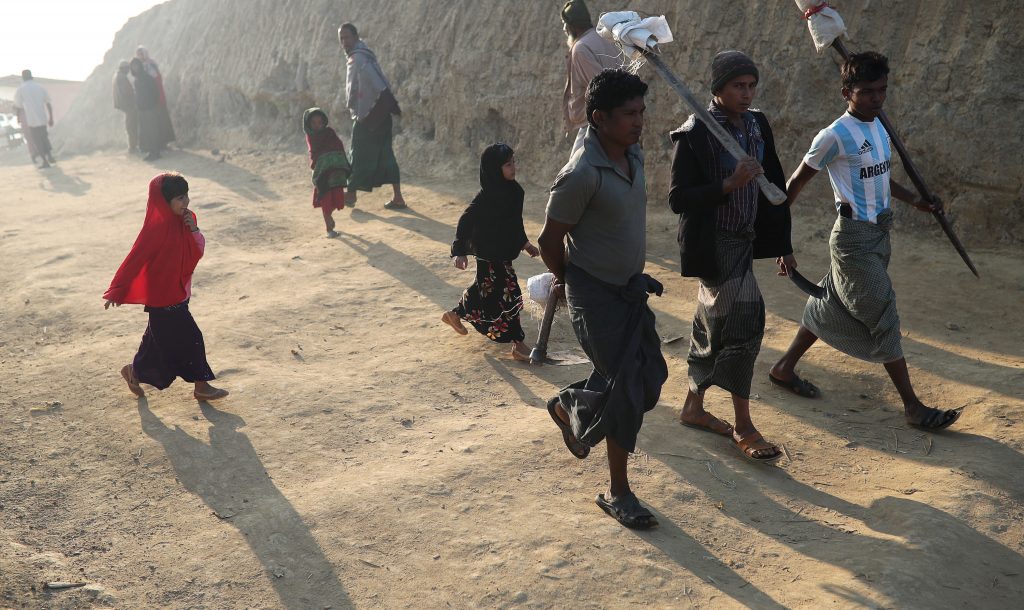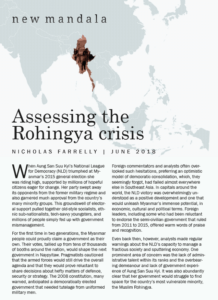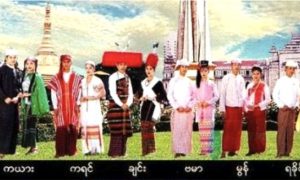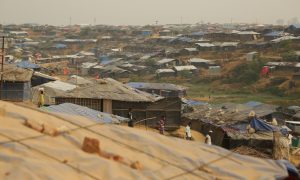When Aung San Suu Kyi’s National League for Democracy (NLD) triumphed at Myanmar’s 2015 general election she was riding high, supported by millions of hopeful citizens eager for change. Her party swept away its opponents from the former military regime and also garnered much approval from the country’s many minority groups. This groundswell of electoral support pulled together old-style socialists, ethnic subnationalists, tech-savvy youngsters, and millions of people simply fed up with government mismanagement.
For the first time in two generations, the Myanmar people could proudly claim a government as their own. Their votes, tallied up from tens of thousands of booths around the nation, would shape the next government in Naypyitaw. Pragmatists cautioned that the armed forces would still drive the overall agenda and that they would prove reluctant to share decisions about hefty matters of defence, security or strategy. The 2008 constitution, many warned, anticipated a democratically elected government that needed tutelage from uniformed military men.
Foreign commentators and analysts often overlooked such hesitations, preferring an optimistic model of democratic consolidation, which, they seemingly forgot, had failed almost everywhere else in Southeast Asia. In capitals around the world, the NLD victory was overwhelmingly understood as a positive development and one that would unleash Myanmar’s immense potential, in economic, cultural and political terms. Foreign leaders, including some who had been reluctant to endorse the semi-civilian government that ruled from 2011 to 2015, offered warm words of praise and recognition.
Even back then, however, analysts made regular warnings about the NLD’s capacity to manage a fractious society and sputtering economy. One prominent area of concern was the lack of administrative talent within its ranks and the overbearing demeanour and lack of government experience of Aung San Suu Kyi. It was also abundantly clear that her government would struggle to find space for the country’s most vulnerable minority, the Muslim Rohingya.
Muslim-Buddhist faultline
Nobody knows for sure how many Muslims live in Myanmar, a consequence of generations of purposeful neglect of this sensitive number. Official estimates drawn from the 2014 census put the total at 2.3%, roughly 1.2 million people, down from 3.9% at the 1983 census. The reason the number is so sensitive is simple: if the government announced that, for instance, 6% of the population is Muslim then long decades of fiction-making about the official numbers of Muslims would need to be re-done. Of course, the Rohingya were not counted in 2014. If they were, the question—regardless of how big a proper count revealed the Muslim population to be—would quickly become: how has Myanmar become so Islamic and how can this trend be reversed.
Assertive and well-resourced organisations in Myanmar are already committed to defending their Buddhist civilisation against those they consider foreign invaders. Muslim groups, under current conditions, are an easy target for hate, with a wide-ranging consensus now among Myanmar people that the government needs to enforce hard-line policies towards them. The hardest responses have been focused, since mid-2017, on the borderlands where Myanmar rubs against Bangladesh. Since mid-year, almost 700,000 Rohingya Muslims have fled to Bangladesh to escape a vicious campaign of communal and state-sanctioned violence. The Myanmar government presents its actions as a justified response to increasing Rohingya militancy, including attacks on government security outposts. Myanmar has also sought to obstruct independent investigations.
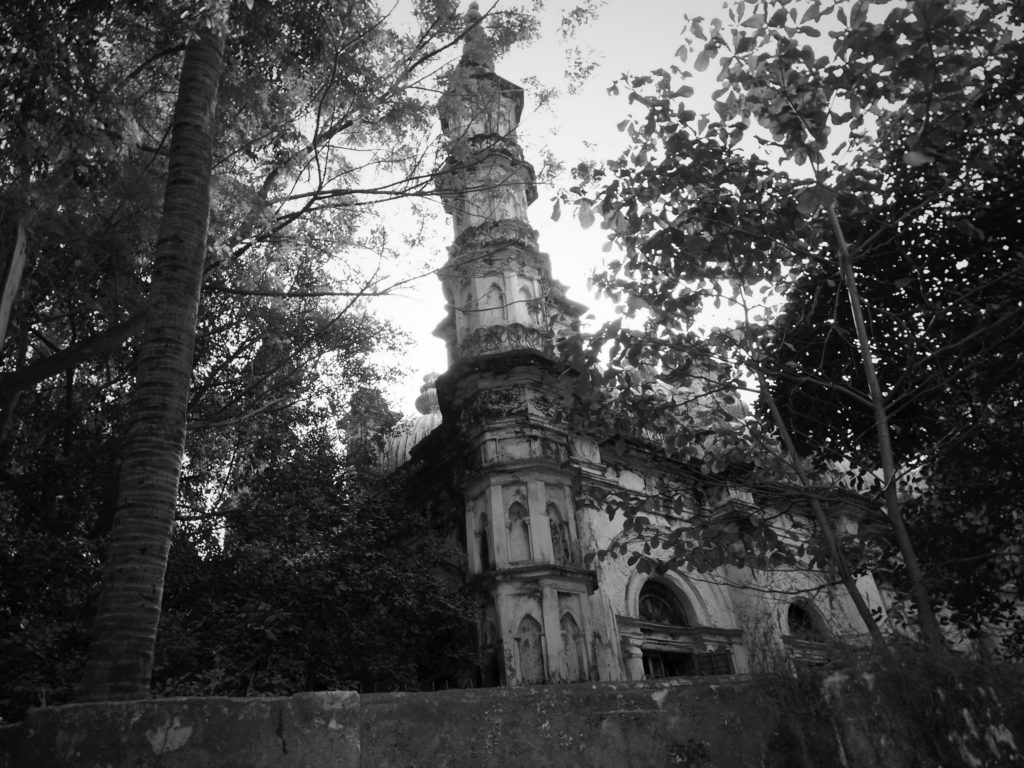
The Jama Masjid in Sittwe. Photo: Flickr user Adam Jones, used under Creative Commons.
Yet what has emerged has shocked even hardened humanitarian agencies, with allegations of horrifying inhumanity. A senior United Nations representative, Zeid Ra’ad Al-Hussein, has called it a “textbook example of ethnic cleansing” while the President of France, Emmanuel Macron, has labelled the Myanmar government’s action “genocide”. In the aftermath, Bangladesh and international agencies are struggling to provide adequate food, sanitation and shelter to the newly displaced people. They seek refuge among earlier waves of Rohingya, who have left their homes in Myanmar since the 1970s. With the 2018 monsoon bearing down on Bangladesh’s coastal areas, further woe and hardship is a near certainty.
Aung San Suu Kyi’s tragedy
International condemnation, meanwhile, has only served to bolster the resolve of the Myanmar side, with outpourings of support for the government. At protests, in Myanmar and around the world, thousands of people have pledged their loyalty to Aung San Suu Kyi and their support for her policies. Some Myanmar democrats also seek common cause with dictators like Russia’s Vladimir Putin or China’s Xi Jinping. It is a peculiar turn of events. Aung San Suu Kyi’s most ardent boosters caution against attributing responsibility for the violence to the NLD. They quietly blame the armed forces—which, under the 2008 constitution, control the Ministries of Defence, Home Affairs and Border Affairs—for all operational indiscretions.
What this analysis ignores are the positions that Aung San Suu Kyi holds, as State Counsellor and Foreign Minister, and the potential for influence these offices afford her on important aspects of policy in Rakhine State. For instance, she could have set a very different tone in terms of international access, humanitarian response, journalistic reporting and military impunity. Among her supporters, Aung San Suu Kyi’s emphatic unwillingness to publicly engage on the subject matter is excused as a strategic calculation to maintain the current coalition government in power. They argue that without careful phrasing, and fancy footwork, she could provoke the military into decisive action that ends any hope of democratic progress. But Aung San Suu Kyi, they tend to forget, has already toppled from her perch as an icon for democratic principles and human rights. The main question remaining is how far she will fall.
It is a tragedy. Aung San Suu Kyi has the unenviable job of managing Myanmar’s sad legacy of communal, ethnic and religious conflicts. There is no denying the scope or intensity of the problems: even an experienced and well-functioning administration would struggle with the confluence of Buddhist chauvinism, Rohingya militancy and long-term strategic predicaments, including handling Chinese assertiveness.
By any measure, however, the NLD has endorsed some bad decisions that made it more likely the festering wound of Rohingya grievances would explode into full-blown humanitarian disaster. For a start, the NLD high command decided to endorse no Muslims as candidates at the 2015 election. The decision was based, as such cowardly ones usually are, on a determination of short-term electoral need. They were worried that looking cosy with even one Muslim politician would alienate Buddhist voters. The same set of concerns emerged after the assassination of Ko Ni, a long-time activist lawyer and occasional NLD advisor, killed at Yangon airport in early 2017. Aung San Suu Kyi took a month before she spoke publicly about his death.
Apologists seek explanations for these decisions in the rough-and-tumble of Myanmar political deal-making. But by prioritising short term political expediency over the longer term goal of intercommunal cohesion, the NLD has helped shape both the social conditions leading to the dehumanisation of the Rohingya, and the widespread support for military action that has purged them from long-term residence on Myanmar soil. In practice, and much to the dismay of some former supporters, Aung San Suu Kyi and her team of key advisors have found themselves in alignment, on the key questions, with the military and with Buddhist chauvinists. While the world still proclaims that such crimes will “never again” tear at our shared humanity, the further tragedy for Myanmar is that a democratic transition has ended in the sprawling misery of the world’s newest refugee camps.
International responses
While the government and Aung San Suu Kyi have announced their willingness to accept investigations, these were slow to start and will take much time to gather the appropriate evidence.
Testimonials from the Rohingya now sheltering in Bangladesh will take time to evaluate. In some places, the Myanmar army and police and local Buddhist vigilantes have enjoyed plenty of opportunities to cover their tracks. Sadly, by the time comprehensive assessments are available, the world’s attention will have moved on. The possibility of high-level prosecutions, potentially through an international tribunal, are for now only theoretical. Experience elsewhere in Southeast Asia, whether in Cambodia after the Khmer Rouge regime, or Indonesia since the 1965 anti-Communist pogrom, indicates that it may take many decades before any reckoning begins. It is most likely, on recent trends, and given the geopolitical landscape, that perpetrators of human rights outrages will never be held accountable. Foreign governments, therefore, may need to accept that engaging with Myanmar in years to come requires dealing with decision makers whom they regard to be individually or collectively culpable for the atrocities witnessed in Rakhine State.
International actors are confronted with little opportunity to avoid such a scenario. Boycotts and sanctions offer a further avenue for international pressure, but it will take significant shifts in existing practice for these to have any real effect. The primary outcome of sanctions, if applied, would see China reinforce its dominant position in the Myanmar economy. Geopolitics is, therefore, a primary consideration.
ASEAN also finds itself unable to respond cohesively. Its authoritarian governments, in places like Vietnam, Laos, Cambodia and Brunei, have too many vulnerabilities of their own to allow countries like Malaysia and Indonesia to push an active agenda on accountability in Myanmar. Instead, ASEAN will take the predictable path of least resistance, at least in public. Such lacklustre responses will frustrate progressive voices concerned that ASEAN’s impotence undermines its standing around the world.
Within the Muslim-majority societies of ASEAN, there is a further complication in domestic political terms. Both Indonesia and Malaysia have large and vocal Islamic political movements that seek justice for the Rohingya—typically marked by appeals to religious solidarity rather than universal rights norms. Protests in Jakarta and Kuala Lumpur could build, under the right political conditions, to exert pressure on national governments, and therefore on ASEAN.
ASEAN solidarity is a fragile concept at the best of times, and further stresses will emerge from the Bangladesh–Myanmar borderlands before long. Whether such stresses come in the form of additional violent outbreaks or irregular people movements, ASEAN would struggle to build collaborative and meaningful initiatives. One of the grouping’s relatively recent successes, the response to Myanmar’s 2008 Cyclone Nargis, was made possible by the astute brokering of a pan-regional alliance, which saw the military allow international humanitarian aid into the country. No comparable diplomatic coalition has emerged to help the Rohingya, and Myanmar has no appetite whatsoever for any ASEAN “intervention”. The “ASEAN Way” of diplomacy, often held up as a more effective alternative to the so-called megaphone diplomacy of some western actors, has not borne fruit, with the “five plus one” plan proposed by Indonesia gaining no traction. The gentle pressure brought to bear on Aung San Suu Kyi at the Australia-ASEAN Special Summit in March 2018 also had no discernible effect.
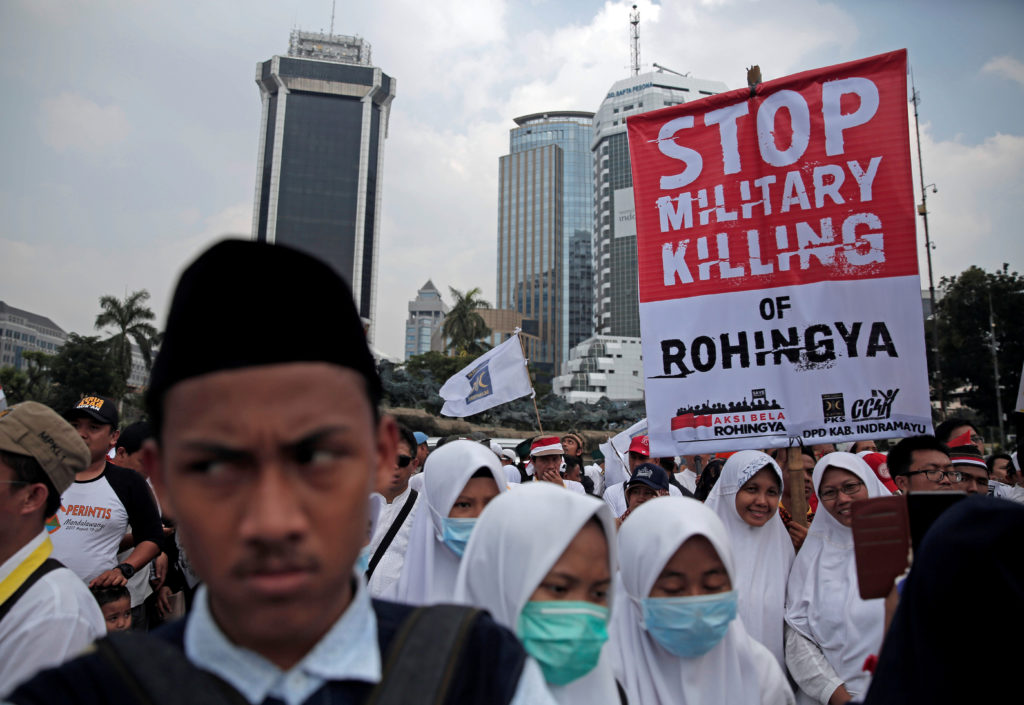
Muslim student holds poster during a protest against the treatment of the Rohingya in Jakarta, 16 September 2017. REUTERS/Beawiharta
By stonewalling in the face of quiet, good-faith diplomatic appeals, Myanmar’s leaders have ensured that over the years ahead their country’s position on the global stage will weaken further. Already, Myanmar has been forced back into the embrace of China’s Communist leaders, who will seek to maximise their own advantage form this latest crisis. Beijing’s self-declared disinterest in the human rights dimensions of Rohingya suffering help to keep the conversation with Naypyitaw on topics of comfortable, mutual concern, like economic development and countering Islamic violence. The Chinese will, no doubt, offer up “lessons” from battling Uighur militants in their restive Xinjiang province. Other dictatorial regimes, such as Russia and North Korea, will also huddle around, eager to make sure that Myanmar is not left alone.
While western democracies, including Japan, will continue to offer a range of responses, some robust and others quite meek, it makes sense that the general tone of these relationships will cool in the years ahead. Even without formal sanctions and boycotts, many people will think twice before committing significant resources to Myanmar. In part, this is a pragmatic response to instability and uncertainty, and to the broader recognition that the NLD government remains ill-equipped to handle major issues and to steward positive social and economic development.
Such a response will also be informed by wariness and anxiety, of a much less precise form, around doing business with a government and people that have accepted or quietly endorsed such suffering. Shareholder activism against companies involved with Myanmar could return as a factor for investors. Within democratic societies there are many different ways that pressure on Myanmar can be exerted, and governments in liberal systems often have only modest influence over the direction taken by society at-large.
Humanitarian priorities
With so much hardship, providing support for the Rohingya in Bangladesh will need to be a global priority for the very long term. Making sense of the scale of the dislocation, trauma and damage has been difficult to do as the numbers of people involved swelled so quickly. Naturally enough, most of the initial attention and effort has dealt with the near-term humanitarian crisis.
Of all the possible outcomes of the refugee crisis sparked by the Rakhine violence, the most likely is that most of the people who fled Myanmar in 2017 will end up stuck on the Bangladesh side of the border for years to come. Reports suggest the Bangladesh government is hastily constructing an off-shore residential facility. The only likely effect of this plan would be to reinforce the vulnerability of the Rohingya, and to cut them off from what sources of social and economic support and sustenance they have in Bangladesh.
In this dire situation, the refugees themselves have no good options. As recently as 2015, tens of thousands of Rohingya set out by sea for sanctuary elsewhere in Southeast Asia, mostly in Thai- land, Malaysia and Indonesia. Australia’s unflinching responses to that crisis, encapsulated in then prime minister Tony Abbott’s blunt rejection of resettlement pathways, means that large numbers of people are currently waiting, especially in Indonesia, for opportunities to move elsewhere.
In the aftermath of the 2017 crisis, secondary movement has been much more limited. It may be that the recently displaced simply have no energy and few resources to invest in ambitious and costly sea journeys. For all the rhetorical displays of solidarity made by Malaysian and Indonesian politicians, there seems to be little serious consideration in Southeast Asia’s two large Muslim-majority countries of allowing Rohingya to access legal, long-term sanctuary there.
The possibility of further violence also preoccupies security planners in Myanmar and across the region. Attacks on Myanmar interests, especially from Muslim fighters from outside the country, could spark significant re-escalation within Myanmar. The Rohingya have become a lightning rod for dissent across the Muslim world, with groups like Al-Qaeda reportedly pledging future support.
Aung San Suu Kyi’s end-game
Under these conditions, and whatever happens next, the NLD-led coalition government has exhausted the tolerance of many former friends. Harsh criticism will now punctuate its interactions with overseas actors, as it seeks to manage what was an avoidable conflict and a dreadful waste of Myanmar’s enormous potential. Those wasted opportunities are most apparent in Aung San Suu Kyi’s personal failures and missteps. When she was still under house arrest, many activists, in Myanmar and abroad, could not have conceived of how comprehensively the pro-democracy leader has endorsed and re-fortified the ideology of national races. She may have once imagined that she could escape the limitations of Myanmar’s ideology around belonging and exclusion, and yet her performance as State Counsellor has only re-entrenched the sharpest delineation—between the Rohingya and the rest. It is one reason that progressive supporters have abandoned Aung San Suu Kyi; they feel betrayed.
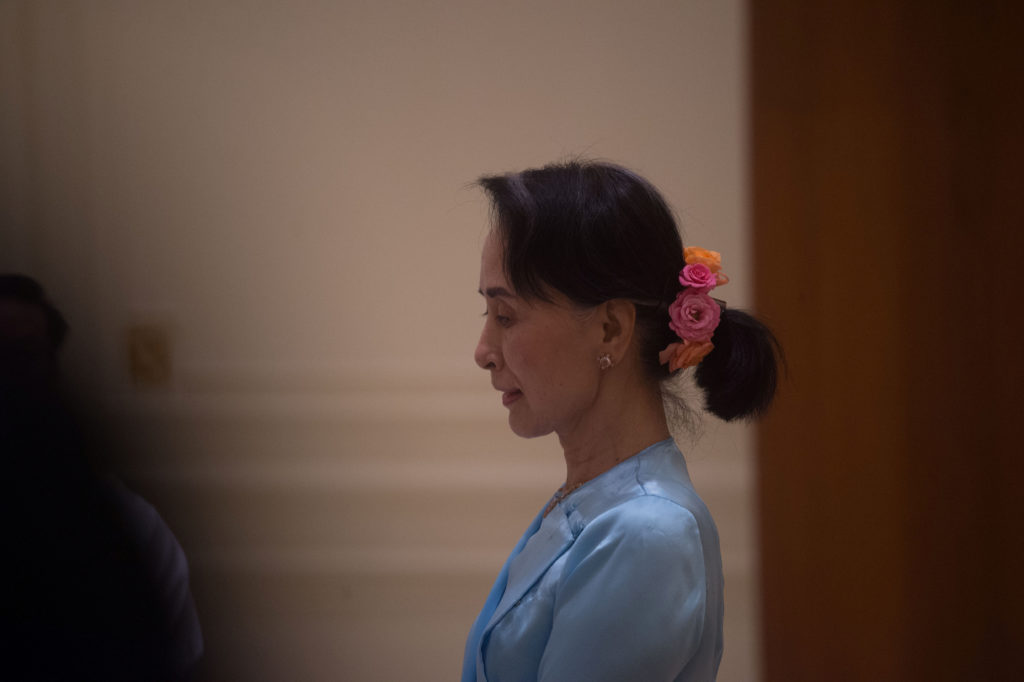
Aung San Suu Kyi at the presidential residence in Naypyidaw, 28 November 2017. REUTERS/Phyo Hein Kyaw/Pool
Where she once appeared brave, principled and dignified, she now hides away in Naypyitaw, the custom-built dictators’ capital. The physical separation also implies an intellectual and informational one; drawing on an increasingly exclusive and insular circle of close confidants, she is exposed to little of the robust and public discussion of the issues that will define her legacy.
We also should not forget that Aung San Suu Kyi is, at the same time, the leader the Myanmar public want and voted for. In crude electoral terms Aung San Suu Kyi’s team cannot afford to look cosy with Islamic interests, not least, ironically, because of the atmosphere of anti-Islamic hysteria the administration has allowed to develop.
With every recent step, the National League for Democracy has sought to stomp on any suggestion that it welcomes Muslims or is soft on national security. Under these conditions, the execution in good faith of plans to repatriate any significant number of Rohingya look unlikely. With a deteriorating security situation in Rakhine State between government forces and the Arakan Army, a Buddhist ethnic militia whose bloody insurgency has generated little international media coverage, there is little appetite for re-introducing complicating factors, such as the Rohingya.
A better political economy of the Rohingya crisis
Crude speculation about ‘land grabs’ obscures the complex historical roots of today’s Rohingya persecution.
Despite the understandable preoccupation by many observers with questions of Aung San Suu Kyi’s culpability, our analysis needs to move past the heavy emphasis on her personal and political ambitions. It has become clear that she will not offer a timely or satisfactory response to the Rohingya crisis. Myanmar will, one day, need to adjust to government after her long shadow has receded.
What will end up replacing Aung San Suu Kyi’s fragile coalition will draw its strength from the groups that have prospered during the recent crisis: the military, Buddhist chauvinists, and the conservative bureaucratic elite. These groups are all well-positioned ahead of the expected 2020 election. Aung San Suu Kyi’s team may still end up victorious at future polls, but the NLD will never again be considered a substantial alternative to the worst aspects of Myanmar governance. It has now become an active contributor to a series of desperately sad political and social outcomes. The terrible conclusion is that, for all the recent suffering in Myanmar, things could still get worse.
 Facebook
Facebook  Twitter
Twitter  Soundcloud
Soundcloud  Youtube
Youtube  Rss
Rss 